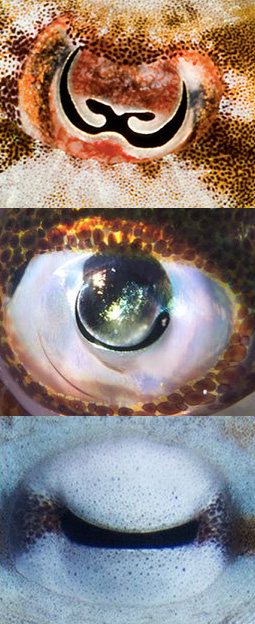As if we needed more evidence that cephalopods are on the verge of a global uprising that will end in humanity’s destruction, our favourite tentacled invertebrates appear to have an insane visual system that allows them to perceive colour despite being technically colourblind. This, along with distributed brains and the ability to bust out of jars from the inside? We’re screwed.
Image: NOAA
The latest fascinating cephalopod insights come to us from a father/son team of researchers at the University of California, Berkeley and Harvard University, who’ve learned that weirdly-shaped pupils may allow cephalopods to distinguish colours differently from any other animals we know of. The discovery is published this week in the Proceedings of the National Academies of Sciences.
Boring animals like humans and birds see colour using a combination of light-receptive cone cells, each of which contains pigments that are sensitive to a different part of the visual spectrum. It’s only by combining information from different cone cells that colours can be properly distinguished. Hence, when a person lacks a particular type of cone, he’s considered colourblind.
Cephalopods only have a single type of light receptor, which means they should not be able to distinguish colour at all. And yet, many octopuses, squids and cuttlefish have colour-changing skin that’s used for elaborate camouflage ruses and courtship rituals. Clearly, these colourblind animals have become masters of colour manipulation. How?

From top, a cuttlefish, squid and octopus eye, whose weird shapes may allow cephalopods to distinguish colour despite being technically colourblind. Image: Roy Caldwell, Klaus Stiefel, Alexander Stubbs
The key may lie in those bizarre U-shaped, W-shaped and dumbbell-shaped pupils, which act like prisms, scattering white light in all directions. This effect, called chromatic aberration, is something round-pupiled animals try to avoid, although you may have experienced it if you’ve ever had your eyes dilated. Instead of focusing light through a narrow pinhole like other animals, cameras and telescopes, cephalopod pupils blow light out.
Once light has been separated into its component wavelengths, cephalopods can use physical tricks — for instance changing the depth of the eyeball, or altering the distance between lens and retina — to focus different wavelengths of light on the retina individually. This allows for colours to be discriminated.
At least, that is a hypothesis now supported by extensive modelling simulations of the cephalopod visual system, which were developed by biology graduate student Alexander Stubbs in collaboration with his father Christopher Stubbs, an astrophysicist.
“Their vision is blurry, but the blurriness depends on the colour,” the younger Stubbs said in a statement. “They would be comparatively bad at resolving white objects, which reflect all wavelengths of light. But they could fairly precisely focus on objects that are purer colours, like yellow or blue, which are common on coral reefs and rocks and algae.”
In fact, having a single, flexible light-receptor may actually be better for the low-light conditions cephalopods often find themselves in. “In the human retina, if a red photon hits a green photoreceptor cell, it probably won’t trigger, and that photon is lost,” Stubbs told Gizmodo. “You might imagine that with one spectrally broad photoreceptor spread across your entire retina, you’re going to have a lot less total loss of photons.”
Of course, the hypothesis still needs to be followed up with octopus-tailored colour vision tests, something Stubbs is hopeful that other cephalopod researchers will now be inspired to do. “One thing we did extensively was look at the last 60 years of behavioural experiments and see if they fit with this model,” he said. “As far as we can tell, they do. But it would be really nice to see someone do the experiments with modern instrumentation.”
Intriguingly, the system of colour perception Stubbs is proposing is more computationally intensive than our own, which could help explain why cephalopods have such large brains. “The visual cortex comprises a huge percentage of the cephalopod brain,” Stubbs said. “It’s beyond the scope of this study, but I’d love to learn more about how they’re able to make calculations for distance, and sensing different wavelengths.”
So there you have it: An incredibly intelligent animal, probably with superhuman visual acuity, which is currently multiplying like mad and taking over the oceans. What could possibly go wrong?
